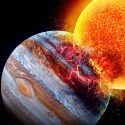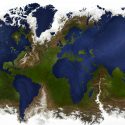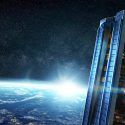These balls represent one of the strangest phenomena currently taking place in our Universe. Each ball symbolizes one of 100,000 galaxies — including our own — that are currently being pulled towards a mysterious point in our universe called The Great Attractor.
We can’t see what exactly is pulling us there, but the only force that would be capable of doing so is gravity. So whatever is out there, it’s massive and unrelenting.
How far away is the Great Attractor? What happens if our Galaxy gets pulled into it? And will we ever be able to see the source of its power?
Going back to our ball example, you can see that if you have 100,000 galaxies all moving towards the same destination, the odds are that some, if not most of them, are going to collide with each other! And if you’ve been watching our videos, you probably know that almost every one of those galaxies would have a black hole at its center. So what can we expect to happen when nearly 100,000 black holes merge with one another?
Before we get ahead of ourselves, let’s get to know these 100,000 galaxies a little better. Our Galaxy, the Milky Way, belongs to a group of a few dozen galaxies called the Local Group. Just like the Sun’s gravity pulls the Earth toward it, our Galaxy is pulled towards the other galaxies in our Local Group.
Our Local Group belongs to an even bigger collection of galaxies called the Virgo supercluster, and that supercluster belongs to an even larger supercluster, known as Laniakea. The one thing all these clusters have in common is that they’re all being pulled towards one specific spot, 220 million light-years away, known as the Great Attractor.
Its vast distance, coupled with all the gas and dust that surrounds it, has made it virtually invisible ever since its discovery — until now. Thanks to X-ray and radio astronomers, we can now see behind this cloud of gas and dust, so now we know that this Great Attractor is really just another supercluster named the Norma Supercluster.
Norma has the mass of about 1,000 trillion suns, which might explain why it’s so attractive to those 100,000 galaxies. So now we know where our Galaxy is heading, and why we’re heading there. But what could happen along the way?
Well, for one thing, we could collide with another of the 100,000 galaxies heading that way, the most likely one being our closest neighbor, Andromeda. If these two spiral galaxies collided, they would merge into one new elliptical galaxy.
During the collision, vast clouds of hydrogen would become compressed, and rapidly create new stars. This would result in the premature aging of the “new” galaxy as it used up its fuel.
That doesn’t seem too bad, but that’s because the black holes in the center of these galaxies haven’t collided yet. When these two black holes merge, it will release energy equivalent to 3 times the mass of our Sun within a matter of seconds. That would be enough power to create a disturbance in the space-time continuum.
And that’s just two black holes colliding. If all the black holes of the 100,000 galaxies drifting towards the Great Attractor merged together, it would release more energy than we could ever imagine.
But luckily we won’t have to worry about that, because these galaxies will probably never arrive at the same spot and collide. You see, the Great Attractor is also being pulled deeper into space by other massive clusters.
And these 100,000 galaxies are also constantly drifting apart, further away from each other. The Universe is constantly expanding, and that expansion will be stronger than the Great Attractor’s pull.
What will eventually happen is that Laniakea itself will come apart, and all the galaxies within this supercluster will start to drift even further apart. So there’s no big collision, no humanity-destroying event to end this episode. Just a bunch of galaxies drifting off into the abyss. Will they ever stop?
Subscribe to What-If on YouTube or follow the show on Facebook Watch.
Sources
- “What Is The Great Attractor? – Universe Today”. 2014. Universe Today.
- “Will the ‘Great Attractor’ Eat Our Galaxy?”. 2020. Seeker.
- “The Cosmic Web“. 2020. outerspacecentral.com.
- “Will the Great Attractor Destroy Us?”. Sutter, Paul. 2016. space.com.
- “What is the cosmic microwave background radiation?”. Scientific American.
- “Our Home Supercluster, Laniakea, Is Dissolving Before Our Eyes”. Siegel, Ethan. 2020. Forbes.
- “Galaxy collision to send solar system flying?”. Imster, Eleanor. 2020. earthsky.org.
- “What happens when galaxies collide?”. Matt Williams, 2016. phys.org.



























